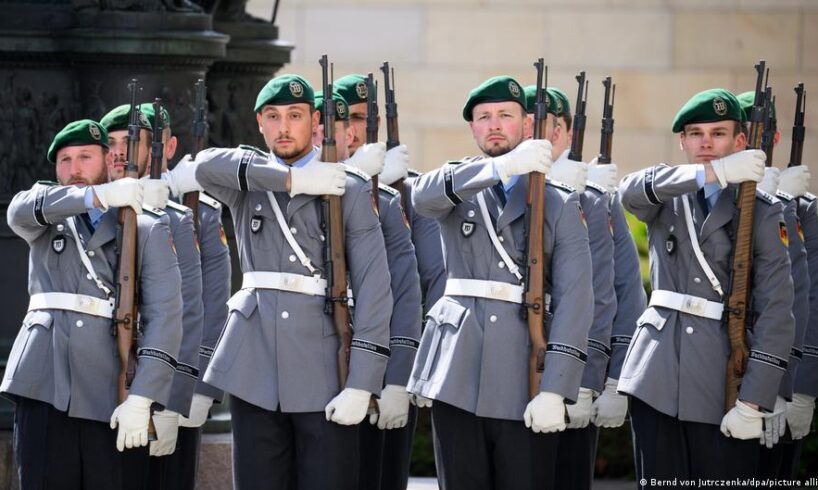
In 1945, few would have predicted that Germany would reestablish an army just a decade later. Following the end of World War II — which Nazi Germany had unleashed — the country was occupied and the Wehrmacht was dissolved. The victorious powers, namely the Soviet Union, the USA, Great Britain and France, undertook a comprehensive demilitarization; war was never to emanate from German soil again.
Tensions among the victorious powers escalated soon after the war, leading to Germany’s division. In the wake of the Korean War’s outbreak in 1950, the Western allies intensified preparations for a potential Soviet offensive in Europe. The border between East and West Germany was seen as a likely flashpoint.
This concern also weighed heavily on Konrad Adenauer, the first chancellor of the fledgling Federal Republic. “In the event of Russian aggression, we would be the victim, the first victim,” warned the conservative in October 1950. “The Cold War is being waged against us with full force.”
Confronted with this threat, Adenauer called for reinforcements from the Western occupation forces. In response, they insisted that West Germany take responsibility for its own defense. So began the contentious debate over rearmament — a cause Adenauer pursued with unwavering resolve.
A return to full sovereignty was the goal of German Chancellor Konrad Adenauer (center), pictured here at the Atlantic Council shortly after the Federal Republic of Germany joined NATO in May 1955Image: UPI/dpa/picture alliance
Resistance to rearmament
For the Catholic Rhinelander, who had little personal affinity for the military, strategic objectives took precedence. He viewed the defense contribution as a pathway to reintegrate Germany into the Western community of states. Above all, Adenauer sought to restore Germany’s freedom of action in foreign affairs.
Just a few years after the fall of the Nazi dictatorship, the prospect of rearmament outraged many Germans. The center-left Social Democrats, then in opposition, voiced sharp criticism. They were appalled by the idea of German soldiers marching once more. Adenauer, they claimed, was exploiting the “fear of the East.” They also warned that rearmament would entrench Germany’s division.
Public resistance intensified. Rallying under the slogan “Ohne mich!” (“Count me out!”), demonstrators voiced their opposition to rearmament. Among them were former soldiers and war invalids, some on crutches or with wooden legs — stark reminders of the recent past.
Ultimately, Adenauer prevailed. The Paris Treaties and Germany’s accession to NATO on May 6, 1955, paved the way for the establishment of the Bundeswehr. On November 12, 1955, Theodor Blank, the Federal Republic’s first Defense Minister from Adenauer’s center-right Christian Democratic Union (CDU), presented appointment certificates to the first 101 volunteers — many still in civilian clothes — at the Ermekeil Barracks in Bonn.
“The Germans were never pacifists,” observes military historian Sönke Neitzel of the University of Potsdam in an interview with DW. “There was a significant minority against rearmament, but a majority supported it. And Adenauer won the 1957 general election with an absolute majority. If Germans had been so opposed to rearmament and the introduction of conscription on April 1, 1957, they wouldn’t have voted for Adenauer.”
Germany debates return to compulsory military service
To view this video please enable JavaScript, and consider upgrading to a web browser that supports HTML5 video
A democratic military ethos
To prevent the Bundeswehr from becoming a “state within a state,” it was firmly embedded within the structures of parliamentary democracy. Supreme command rested with the civilian defense minister.
Soldiers were — and remain — bound by conscience as “citizens in uniform,” a deliberate countermodel to blind obedience. “We want armed forces in a democracy that submit to the primacy of politics,” emphasized Defense Minister Blank.
Although the Bundeswehr’s political and social orientation was new, personnel continuity remained. Some officers had previously served in the Wehrmacht. With no other pool of experienced military professionals available, their inclusion was unavoidable.
Yet they were successfully anchored to the Republic, notes Neitzel. “This Wehrmacht generation served the Republic loyally,” he observes. “The Bundeswehr was never a threat to democracy.”
During the Cold War, the Bundeswehr was tightly integrated into NATO’s command structures. Its mission remained strictly defensive: to protect West Germany in the event of an attack. By the mid-1980s, it had reached its peak strength with 495,000 soldiers.
After the East-West conflict ended, the Bundeswehr faced a new reality. Following reunification, the National People’s Army of the German Democratic Republic (GDR) was dissolved, and its 90,000 soldiers were placed under Bundeswehr command. Only a small number were permanently integrated.
Germany’s traumatized Afghanistan veterans
To view this video please enable JavaScript, and consider upgrading to a web browser that supports HTML5 video
Focus shifts from national defense to global deployment
Surrounded by friendly nations, Germany’s territorial and alliance-based defense lost significance. The Bundeswehr was gradually reduced to fewer than 200,000 soldiers.
Its focus shifted to so-called “out-of-area operations” beyond NATO territory, a role approved by Germany’s Federal Constitutional Court in 1994. German troops went on to serve as peacekeepers across multiple continents. The most costly and deadly deployment was in Afghanistan (2001-2021), where 59 German soldiers lost their lives.
The result of this strategic shift was a downsized volunteer army that was virtually incapable of fulfilling territorial and alliance defense. “That was certainly short-sighted,” says military historian Neitzel. “Above all, it was a political problem, because the necessary funds were not provided. It was a political decision to keep reducing the army, culminating in the suspension of conscription in 2011. As a result, the Bundeswehr could only maintain a core set of capabilities.”
A defense stress test: How prepared is the German military?
,
To view this video please enable JavaScript, and consider upgrading to a web browser that supports HTML5 video
New tasks for the Bundeswehr
Only since Russia’s full-scale invasion of Ukraine in 2022 has this begun to shift. Since then, politicians have invested heavily in modern weaponry and improved equipment for the armed forces. According to plans by Chancellor Friedrich Merz (CDU), the Bundeswehr is to become the “conventionally strongest army in Europe.” To achieve that goal, it urgently needs more personnel — prompting intense debate over the possible reintroduction of conscription.
Despite ongoing challenges, public support for the Bundeswehr remains strong. Seventy years after its founding, more than 80% of Germans hold a positive view of the armed forces, according to a representative survey conducted by the Bundeswehr’s Center for Military History and Social Sciences.
This article was originally written in German.
While you’re here: Every Tuesday, DW editors round up what is happening in German politics and society. You can sign up here for the weekly email newsletter, Berlin Briefing.





